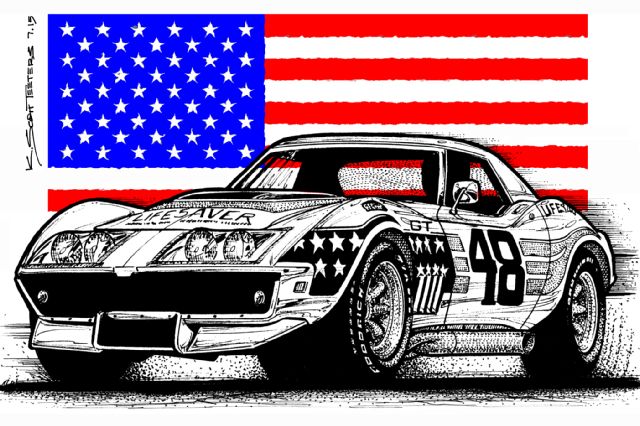
On July 7, 2015, the Corvette community lost another legend; John Greenwood passed.
Words and Art by K. Scott Teeters as written for Vette Magazine, republished from SuperChevy.com
Illustrated Corvette Series No. 223
On July 7, 2015, the Corvette community lost another legend; John Greenwood passed. He was 70 years old. John was a member of a very small club of legendary Corvette figures that only needed one name, such that when you said that one name, it spoke volumes. Just a few others are: Shinoda, Lingenfelter, Callaway, Yenko, Guldstrand, and of course, Duntov. Engage any serious Corvette person in some bench racing, drop the name Greenwood and instantaneously all manner of mental images come to mind: suspension packages, C4 body kits, BFGoodrich Stars and Stripes, 427 ZL1 racers, and the most outrageous Corvette racers ever, the C3 widebody “Batmobile” Greenwood IMSA cars.
It wasn’t just John Greenwood’s victories that made him a Corvette legend, as there have been many other racers that have racked up more wins and championships. Greenwood did three major things and he did it with an all-American style that was remarkable.
Beginning in 1957, Mr. Duntov always made sure that “his racers” had the best Chevrolet-engineered parts for racing that he could provide, starting with the RPO 684 Heavy-Duty Racing Suspension option. This option, along with the fuelie engine, four-speed manual transmission, Positraction rear, and wider steel wheels formed the basic essentials for the early days of Corvette racing.
In 1963, the Z06 option was released, followed by the 427 L88 in 1967, and eventually the release of the all-aluminum version of the L88, the ZL1. It was as if the ZL1 was made for John Greenwood. In a sense, it was the beginning of the end of the Duntov “racer kit” days. John took the basic L88 racing suspension and ZL1’s ability to produce massive amounts of horsepower and torque where no one had gone before. Combined with gigantic road racing slicks, the factory frame needed so much strengthening that when Hot Rod magazine visited Greenwood’s shop to see John’s first batch of widebody cars, the editors opined, “Is there any Corvette left in this car?”
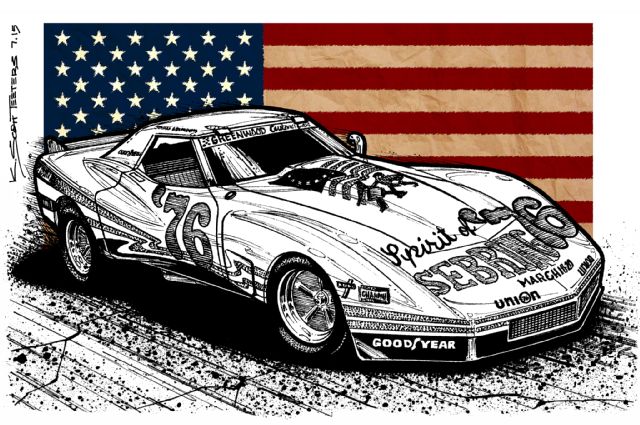
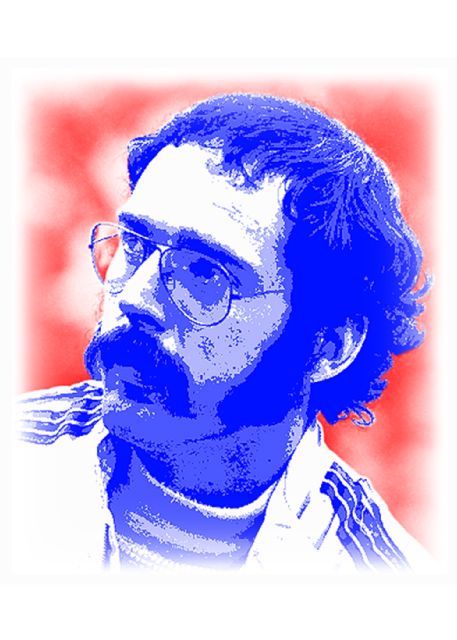
What’s obvious now was “new” back in 1973-’74. It was John Greenwood that suggested to Duntov that a widebody kit should be developed that would cover the widest tires and generate additional downforce. You see, John and Burt Greenwood understood how modern race cars needed to be more than just slippery through the air. The ZL1 could easily spin the biggest tires available, so downforce and air management was the new frontier. GM stylist Randy Whitten penned the shape and when Greenwood’s widebody IMSA racer debuted in 1974, all decked out in a new stars and stripes livery, it looked like the Corvette from another planet. John and Burt Greenwood finished Duntov’s “racer kit” program – it could go no further as a production-based racer. In fact, the next step was back to purpose-built, tube frame race cars.
The second thing that John Greenwood did, before his racing career took off, was he started his engine-building business ARE (Auto Research Engineering), in 1969. As John learned new ways of coaxing power from big-block Chevy engines, he applied his new insights into his customer work. This set a pattern that continued for years to come. By the time Greenwood was into his IMSA program, he was offering turnkey customer cars. New developments that John worked into his race cars were built into his new customer cars, or would be retrofitted into existing customer cars. Do-it-yourself racers could also buy the complete suspension kit. This was the beginning of the “full-Greenwood suspension” era. In a sense, John and Burt picked up the “racer kit” concept where Duntov left off when he was forced to retire in January 1975.
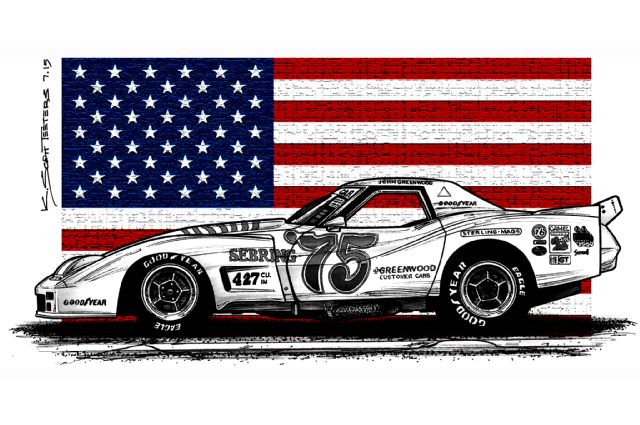
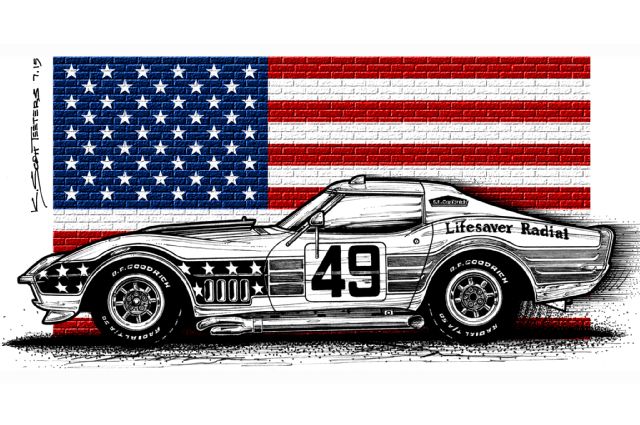
The third thing that John Greenwood did that contributed mightily to his legend status was his custom street cars. Like Joel Rosen’s Motion Performance, customers could buy the body parts for a do-it-yourself experience. Like many kit cars, some turned out good, many not so good. However, if your pockets were sufficiently deep, you could get a fully worked out, quasi-IMSA race car for the street with all the creature comforts of a new, factory Corvette. From 1975 to 1981, approximately 43 custom street Corvettes were built, based on five different body styles. Each car was serialized with an ID nameplate to authenticate the car as a “Greenwood Corvette.”
First were the “GT” and “Sebring GT” cars, built on production 1975-’77 Corvettes. Then there were 30 “GT” cars built for Corvette racer and dealer Rick Mancuso. The “Sportwagon” was a cleaned-up version of the body kit offered by Eckler’s. The “Turbo GT” was an extension of the “GT” and “Sebring GT” that used the widebody style, but more integrated into the fenders and had a large, flat fastback rear window, and a big wing rear spoiler. The turbocharged L82 engine had 7 psi of boost through a Holley 650 carb and used water injection to curb pre-detonation. The “Daytona” was arguably the wildest of the entire race car-based, street Greenwood Corvettes. Based on the shovel-nosed 1980 Corvette, the body used every scoop, vent, fin, duct, and spoiler-effect allowed by IMSA’s loose rules. Only five Daytonas were built and some of the cars had the full Greenwood five-link coilover suspension. The “GTO” Greenwood Corvette was based on the 1981 Corvette and was a less aggressive version of the Daytona. The GTO body design was used on the T&R Racing Greenwood GTO racer and broke track records with speeds over 200 mph.
The late ’70s and early ’80s brought major changes to Greenwood’s business. Even though John had massive Chevrolet backdoor support, there was no competing with the likes of the full-bore factory efforts from Porsche, Audi, and BMW. When the C4 came out John did a little racing in the Playboy Escort Endurance, the IMSA Supercar series, and the 1989 Corvette Challenge – sans the stars and stripes livery. Greenwood’s big “G-Cars” project was so ambitious, it nearly broke the company. There were three versions of G-Cars: the G572, G383, and G350. In hindsight, the G-Cars were an exercise in overkill. Think “exotic race car” meets “exotic luxury car.” The cars were dripping with racing hardware: super-rigid frames; coilover shocks; antidive/antisquat suspension; huge wheels, tires, and brakes, exotic materials for its day, and ultra-custom full aero-body design. The G572 used an all-aluminum Keith Black big-block and the G383 used a stroked Lingenfelter engine. The problem was cost. The entry-level G350 cost just over $100,000, the G383 was to go for $130,000, and the G572 had a proposed price of a staggering $425,000! A few orders were placed for the G350 and G383s, and there were no takers for the G572. A stock LT1 Corvette listed for $36,185 and the nation was in a recession. Timing is everything.

Attaining “legend” status is about more than just statistics: number of wins, track records, or championships. John Greenwood won the SCCA Championship for A/Production in 1970 and 1971, defeating the seemingly undefeatable Owens-Corning Thompson-DeLorenzo team. Greenwood won the 1975 Trans-Am Championship, after Brumos Porsche had dominated the class in 1973 and 1974. Along the way Greenwood cars set track records, qualified number one many times. John was the key sponsor man behind the Sebring ’74, Sebring ’75, and Riverside ’75 racing events. Greenwood put up his own money for the purse and track improvements. And when Greenwood went to race at Le Mans, he was a rock star. The Europeans loved his big, LOUD Corvettes!
John’s stars and stripes #48 car (paint design by Burt Greenwood) graced the cover of the first major Corvette history book, Karl Ludvigsen’s 1973 book: Corvette: America’s Star-Spangled Sports Car – The Complete History. For many years, the publisher of the book, Automobile Quarterly, offered a large color poster of the car as well. And in 1976 Greenwood’s #48/49 BFGoodrich Corvette was on the cover of Vette magazine founder, Marty Schorr’s book, Corvette From Six to Stingray. Many of the Greenwood race cars have been fully restored and whenever they come up at auction, there’s always a lot of excitement.
While sports car racing has never been a poor-man’s sport. John Greenwood was arguably one of the last independent Corvette racers that had enough backdoor factory support to give him a shot at taking on the big European factories. With loud, in-your-face big-block power, in blazing red, white, and blue, everyone knew when John Greenwood was at the track. That’s the stuff of legends. Thanks John, and Burt too.
